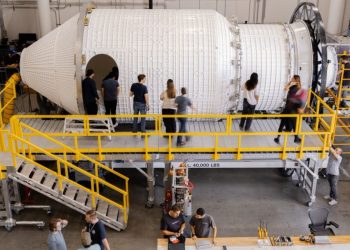On the campus of the University of Southern California, the morning sun illuminated an inflatable replica of a white space station suitable for human habitation. The small sign next to it declared: “Mars: the time has come!” »
Starting Oct. 9, astronomers, robotics engineers and planetary scientists passed the sign on their way to a three-day convention hosted by the Mars Society. They were joined by high school students, science fiction enthusiasts, and computer scientists – people who weren’t yet working in the space industry were bonded by their desire to look at the stars and ask: What’s out there? And: When can I go?
They sipped coffee outside a conference room while exchanging LinkedIn contacts and discussing the presentations they would attend, including “Debating the Martian Constitution” and “Making Quality Coffee on Mars.” Souvenirs for sale included Elon Musk socks, boxers with images of the Hubble Space Telescope and hoodies that read “Occupy Mars.”
Marge Lipton, a 77-year-old volunteer, manned the sales table. “I still remember the roar of the earth and how it inspired me,” said Ms. Lipton, who witnessed the Apollo 15 launch when she was a producer for ABC News. “When I was a kid in the 1960s, I got the space bug and it never left me. For a lot of us here, we want to know what’s on the other side of the river, what’s on the other side of the mountain.”
A fellow volunteer alongside him was busy assembling a Lego space rover.
“We all want to go to Mars,” Ms. Lipton continued, “but we realize that the American people have a lot of other things on their minds right now. How we’re going to get through this moment in America and bring the focus back to Mars, I don’t know. But at least when we’re here, we don’t have to explain ourselves to each other.”
Getting people to care about reaching the Red Planet has been the Mars Society’s mission since 1998, when it was founded by Dr. Robert Zubrin and a network of scientists and engineers unhappy with the National Aeronautics and Space Administration’s waning ambitions.
At the time, the idea of a human colony on Mars belonged to the realm of Isaac Asimov’s stories. Today, thanks in part to Elon Musk and his SpaceX program, that seems closer to reality, even though many members have said they disagree with Mr. Musk’s policy positions.
Andy Greco, a Boeing engineer who lives in Seattle, gave a presentation on the simulated Mars habitat on Devon Island, an uninhabited Arctic outpost in Nunavut, a Canadian territory. As the leader of a research group, he spent two weeks in the isolated base created by the Mars Society in 2000.
“We treat the exterior of the habitat as if it were a mortal space, even waiting for the airlock to be depressurized when we go out,” Mr. Greco, 38, said after his speech. “We know we’re just training, but it makes us think we’re actually on another planet. It was the biggest adventure of my life so far, and it had all the thrilling dangers I read about in science fiction books when I was a kid.”
“I would certainly answer the call for a one-way ticket to Mars,” he added. “For many of us dreamers, it has been part of our imagination for so long that achieving it is not so feasible in our minds.”
Eric Kristoff, a data technology project manager in Chicago, took a break after lectures such as “Your Voice in Congress Matters for a Space Future” and “The Lukashian Calendar: Bringing Time to Mars.” His backpack was covered in patches referencing films like “Alien” and “Total Recall.”
“It started for me when I was a boy,” Mr. Kristoff, 55, said. “But then you grow up. You get a job that has nothing to do with space. You get busy with life and kids. But it all came back to me when they started pulling the Space Shuttle program. That really upset me. ‘How dare you,’ I thought.”
“We still need borders and we need to get back to that border mindset,” he added.
Alexander de Graaf, 13, who had flown in from Vancouver, British Columbia, with his father, paced the halls as he prepared to give a lecture.
“My presentation is titled ‘The Mars Generation: Now’ and focuses on the importance of youth participation in space exploration,” he said. “My friends take me seriously when I talk about Mars at school now, whereas others might have been made fun of years ago.”
“Personally, I think Elon’s prediction is a little crazy, that we’ll have a million people on Mars by 2050, but it’s a good approximation for us,” he added. “But I wouldn’t go to Mars if I was given a one-way ticket. For me, it’s about the message that we are a resilient species and that we can achieve this.”
Dr. Zubrin, founder of the Mars Society, spent much of the conference signing copies of his 1996 book, “The Case for Mars.” “See you soon on Mars!” » he wrote in his inscriptions.
A Brooklyn-born nuclear and aerospace engineer, he joined one of the first space advocacy groups, Mars Underground, while working for Lockheed Martin. When NASA presented a $450 billion proposal in 1990 to send humans to Mars, he was motivated to develop Mars Direct, a $20 billion alternative plan, which later formed the basis of his book. After its publication, Dr. Zubrin received thousands of letters from space enthusiasts, inspiring him to create the Mars Society.
Retreating to an empty classroom, away from his fans, Dr. Zubrin, 73, expressed his opinion on the current state of space exploration. Under President Trump’s proposed budget, unveiled in May, NASA’s annual spending would be cut by about $6 billion.
“The American spirit was once based on the idea that we could do anything,” Dr. Zubrin said. “Now this guy says he wants to make America great again, but here he comes with his budget cuts and destroys one of the things that really makes America great, the American space exploration program.”
“Are we still a nation of pioneers? he continued. “Are we the people of the future or the past? That’s the whole point.”
He also spoke about Mr. Musk, who was a member of the Mars Society when he was young and who spoke at the annual convention. A photograph of the author alongside Mr. Musk appears in the preface to “The Case for Mars.”
“He was our white knight,” Dr. Zubrin said. “I have serious problems with his policies, but that doesn’t mean I don’t admire him for what he’s done for space travel. Everyone here still applauds when Musk and SpaceX do something incredible.”
On the second day of the convention, a gala dinner was held at a nearby senior center that the Mars Society had rented for the evening. Some members dressed up for the occasion, trading Star Wars t-shirts for dress shirts. At the buffet line, they helped themselves to beef tips (“Red Planet Tri Tip”) and eggplant (“Vegan Eggplanet Parmesan”) before taking their seats.
The evening’s keynote speaker was Rob Manning, an engineer who helped lead NASA’s Mars Pathfinder mission in 1996. He was introduced by Mars Society executive director James Burk, a former Microsoft software engineer. In his opening remarks, Mr. Burk recalled the landing of the Pathfinder spacecraft on the plains of Ares Vallis, Mars.
“I remember being glued to the television, because we were going to land on Mars, and this man was the chief engineer directing the entry, descent and landing of the Pathfinder team,” Mr. Burk said. “I can’t believe I’m here to present it. I might pinch myself.”
Mr. Manning quickly took the stage to present a lengthy slide show about Mars. His rapt audience relished the on-screen images depicting the planet’s valleys and craters as well as vintage mission control photos of him with his crew.
Bill Maloney, 29, went outside to admire the night sky with his plate of food. A bright moon was emerging.
“I don’t look so much up as inward,” said Mr. Maloney, a space entrepreneur from New York. “Mars will challenge us, and challenge is what is at the heart of being human. That’s what it’s about. I think we have regressed spiritually as a society, and getting to Mars is a spiritual exercise more than anything else.”
“We’re a quarter of the way into the 21st century and many of us are just praying that the sidewalks in our cities will be cleaner, whereas in the 1960s we were talking about going to the moon,” he said. “The problem with humanity today may not be that our problems are so big, but that our dreams have become so small. March is the first step in changing that.”









